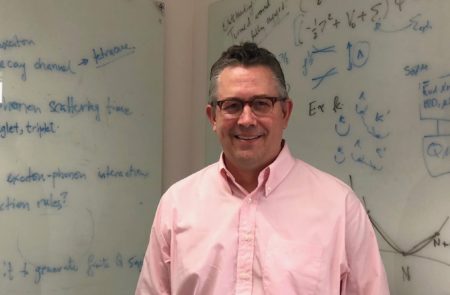 Jeff Neaton is the Energy Sciences Associate Laboratory Director. He joined Berkeley Lab as a postdoc at the Molecular Foundry in 2003 before becoming a staff scientist. While maintaining his research program, he has also taken on many leadership responsibilities at the Lab.
Jeff Neaton is the Energy Sciences Associate Laboratory Director. He joined Berkeley Lab as a postdoc at the Molecular Foundry in 2003 before becoming a staff scientist. While maintaining his research program, he has also taken on many leadership responsibilities at the Lab.
How has your career brought you to where you are today?
I started as one of six jumpstart postdocs at the Molecular Foundry in 2003. In those early days, we were working on campus and in Building 66 with users. Once the Foundry building was completed, I applied for and got one of the career-track staff scientist positions. Shortly thereafter, I became Facility Director of its Theory Facility. I was appointed Foundry director in 2013; at around the same time, I became a professor of physics at UC Berkeley and part of another terrific community where I have continued to grow as an independent researcher, mentor, and teacher. Throughout my career, I have always had these dual roles: leadership of a program or largescale facility while running a research group and developing students and postdocs. And, I’ve always appreciated that special relationship between LBNL and UC Berkeley. Last year, I became the Energy Sciences Associate Laboratory Director (ALD).
What kind of research do you do?
I develop theories and computational methods to predict, understand, and discover new materials and describe their properties from their constituent electrons and nuclei and their mutual interactions. Much of my research has taken place in larger core programs at the Lab and major DOE-BES-funded centers such as the Joint Center for Artificial Photosynthesis, Energy Frontier Research Centers, and the Center for Computational Studies of Excited State Phenomena in Energy Materials. My research is very interdisciplinary—our methods are applicable to many classes of molecules and materials, hard and soft—and involves large-scale computational facilities, in particular NERSC. I enjoy bigger-scale team efforts, and collaborations between theory and experiment. There are challenges in working within larger teams, but a big draw for me to Berkeley Lab is the people, the staff and steady stream of external collaborators and users—I love to work with and be inspired by my colleagues, world leaders in their disciplines.
There’s lots of positive feedback between my leadership responsibilities and research. I am exposed to many new ideas as Foundry director and ALD, and some lead to new collaborations or inspire new research directions. Being an active scientist also brings a useful perspective and broad network to my ALD role.
What is your vision for the Energy Sciences Area, and how does the ALS fit into that?
The ALS is a centerpiece of the Lab, and we’re fortunate to host it in our Area. Scientists in the Materials Sciences Division, Chemical Sciences Division, and Foundry users all have strong connections to the ALS. And I have been so impressed with the scientists and operations staff at the ALS! That said, there’s an opportunity for greater integration of ALS capabilities and expertise across divisions and programs. As ALD, I’ve been hiring division directors and forming a management team to work together to lead the Energy Sciences Area into the next decade. A major objective of this team will be to reduce the barriers to collaborations between these divisions, both scientifically and operationally. A strongly collaborative management approach in ESA will create and take advantage of future opportunities—new science with the upgraded ALS, quantum information science, electron microscopy, biomaterials, microelectronics, machine learning, and more —and help engage and partner with other Areas. The ALS will play a central role here.
One special opportunity for the Energy Sciences Area is the Old Town site next to the ALS. I look forward to working together to develop that site with new state-of-the-art shared-use facilities that integrate the ALS, Foundry, and core programs in order to foster discovery and new understanding.
The users—members of the external scientific community that visit and perform experiments and simulations at the ALS and the Foundry—are a big part of what makes the Lab special. They contribute many ideas to our environment and inspire new directions and programs here. The strong synergy between users and ALS and Foundry staff leads to a dynamic and fertile environment for exploring new ideas. This unique research environment and way of doing science—working collaboratively to advance user and internal research, often at the same time—is a big part of what attracts our world-class staff. This collaborative team science ethos, inherited from the Lab’s inception, is very inspiring.
How has your work benefitted from that synergy?
As a member of the Foundry’s scientific staff, the studies I have been involved with have been most successful when the relationship between user research and my own research was most fluid. Working with users, I contributed to projects I probably wouldn’t have had the opportunity to in a more traditional research environment. Through those experiences, I was exposed to questions and ideas that greatly influenced my personal research directions and expanded my expertise. I also developed a much broader set of interests in the physical and biological sciences, interests I can continue to cultivate in the ALD role.
What do you do in your free time?
I’m an avid reader and I listen to a lot of music. I like fiction and I’ve got a Spotify account. I’m a bit of a foodie, so I like to grill and cook. I follow sports when I can. Exercise-wise, I wish I did more, but there’s nothing I like more than to go on bike rides with my 7-year-old daughter. We like the bike trails in Oakland, like the Nelson Mandela Parkway. In a few years, we’ll go into the hills!